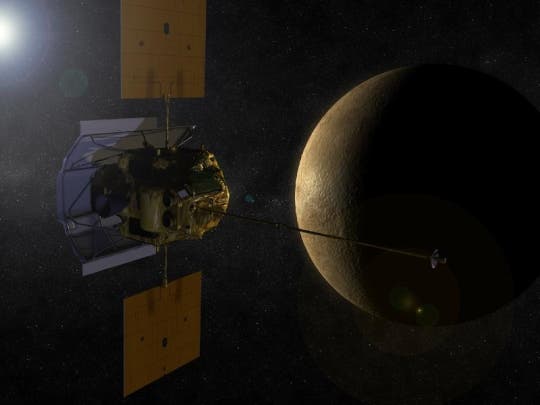
As reported earlier on Thursday morning, the Messenger NASA spacecraft was scheduled for an evening jump into Mercury’s orbit through a tricky maneuver which involved a “burn” – essentially “riding its brakes” by firing its main thruster – to slow the spacecraft enough to be captured by Mercury’s gravity.
At 8:45 p.m. ET, the procedure was commenced. At 9:10 p.m. engineers confirmed that the burn had occurred. By 9:45 p.m. the probe had turned its antenna back toward Earth and began transmitting more detailed data showing that the 15-minute burn was “clean”. Since then Messenger in successfully anchored into Mercury’s orbit!
This is indeed an incredible feat, especially for the mission control team at the Johns Hopkins Applied Physics Laboratory in Maryland which was monitoring MESSENGER’s progress from 96 million miles.
“This is going to be a long night; they’ve got a lot of data to look at. But so far, it’s been a great night,” said Michael Paul, a mission engineer providing color commentary from a nearby auditorium where lab personnel were following the crucial phase of the mission.
About 40 minutes later, mission lead engineer Eric Finnegan announced that the spacecraft was in a near-perfect orbit. “Right down the alley,” he said. “We hit the trajectory to within half a sigma, for my engineer friends in the crowd. It was right on the money.”
Since its launch in 2004, Messenger has flown by Earth once and Venus twice on a circuitous 4.9-billion-mile journey, and made three high-speed flybys of Mercury in 2008 and 2009. However, during its flybys the craft was able only to capture about 45% of the planet’s surface filled with craters.
Now, in orbit, Messenger will be able to take incredibly high-resolution images of the planet’s surface in a year long mission, during which it will orbit Mercury twice every 24 hours—conducting the equivalent of two flybys a day – and sending back reams of data from a suite of onboard cameras and spectrographs. The first data gathered by Messenger is expected in early April.






